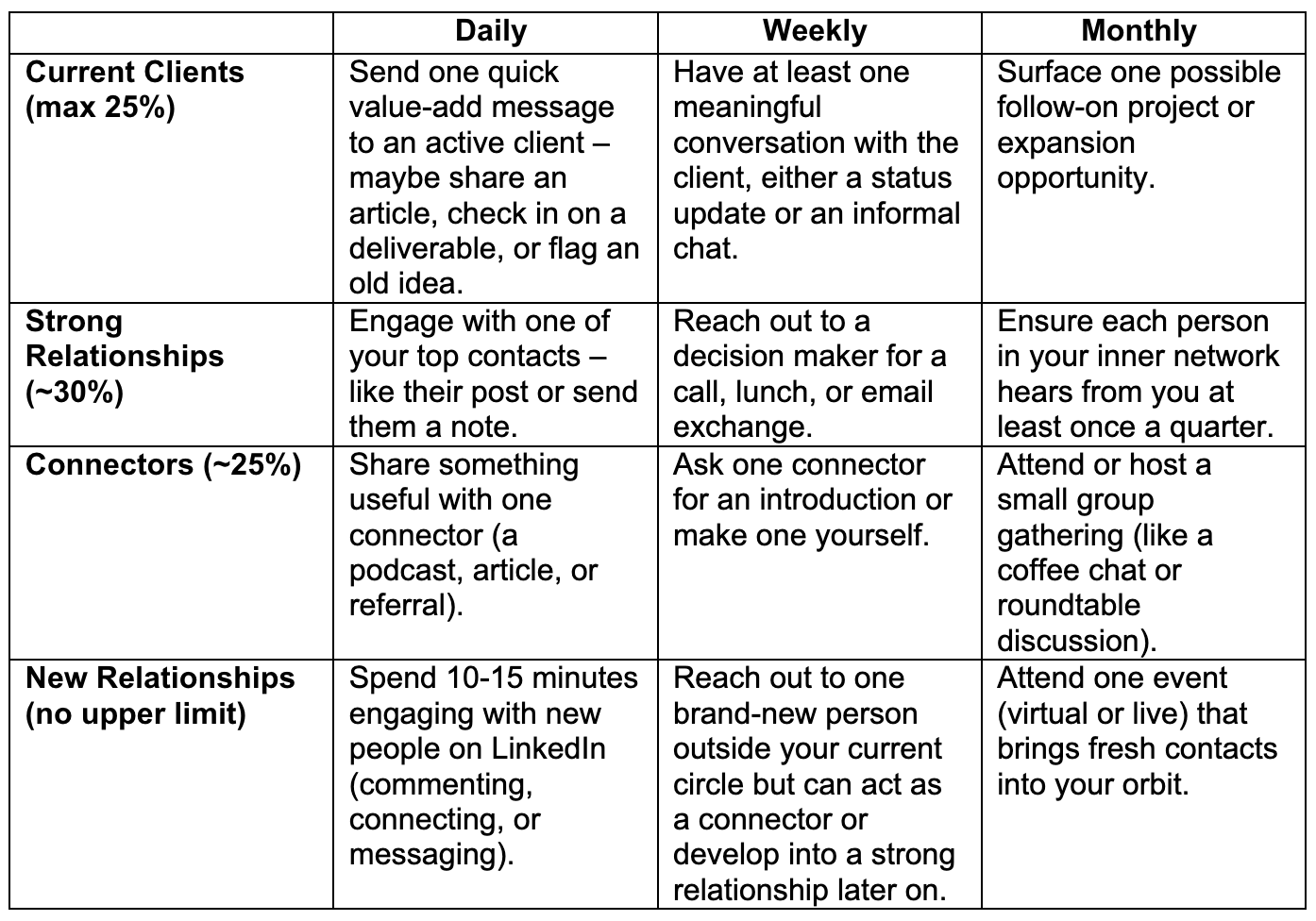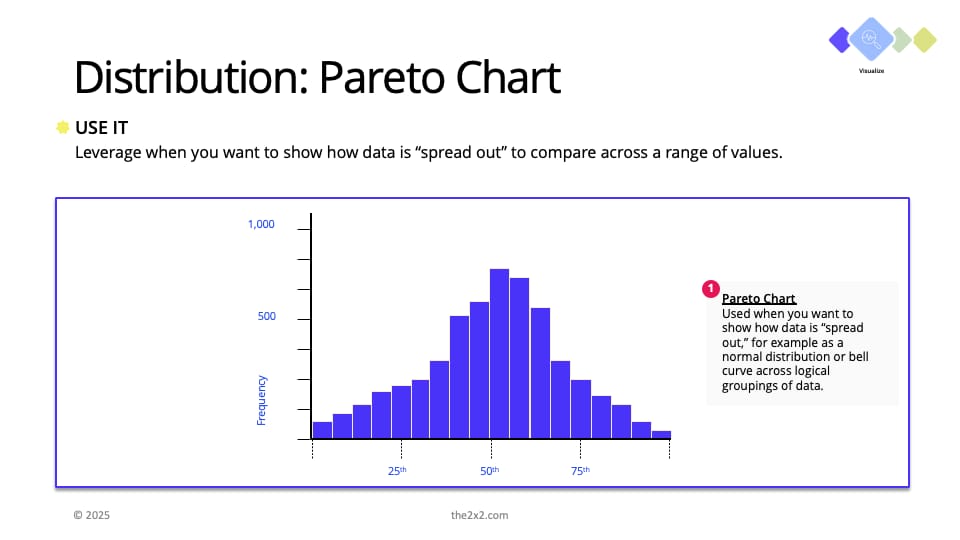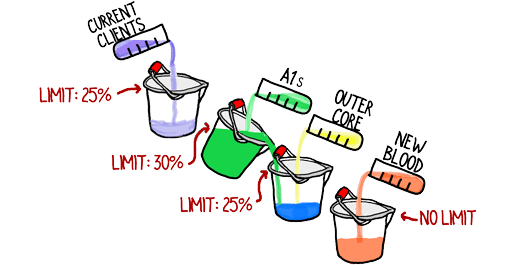- The 2x2
- Posts
- Balance Your Biz Dev
Balance Your Biz Dev
Welcome back to The 2x2 - the ultimate newsletter for executive consultants!
This week, we’re talking about a problem every indie consultant has: serving your clients while balancing your biz dev.
Plus, a new job board at the end. 👀
Read on…
⏰ Today in 5 minutes or less:
Developing your consulting business should be an always on practice, not just when you’re near the end of an engagement.
Organize your prospects into four groups: current clients, strong relationships, connectors, and fresh contacts.
Bucketing your time with different prospects is the key to a balanced biz dev.

How to Balance Your BD Time (Without Losing Your Mind or Your Clients)
Business development is rarely balanced.
We’re all guilty of leaning on current clients too hard when things are busy – telling ourselves we’ll reach out to more prospects later when things are calmer.
But many of us only remember to do that when we’re approaching the end of an engagement, flooding LinkedIn with connection requests and chasing strangers while ignoring the warm relationships already in our corner.
This approach only reinforces the feast-or-famine cycle we all know too well.
Running our own practices means our bandwidth is tighter, and every hour has to count.
I love a process. Once I figured out there was a "process” (ahem, a pipeline) to managing business development, it was a huge unlock.
I also found that by approaching biz dev as a process, I took the emotions out of it. It’s because of a series of actions, rather than a series of interactions.
Thus, anxiety reduced, emotional balance was restored, and lo and behold, I actually did it.
And so, my indie pals, I share that with you today – my steady way to accomplish biz dev without burning out.
Get Your Ducks in a Row
I read David A. Fields’ book on The Irresistible Consultant’s Guide to Winning Clients.
There’s a lot of golden nuggets in that book, but here’s what we’re focusing on today:
If you only focus on one group of prospects, you’ll end up in the feast-or-famine cycle. The real key to sustainable revenue is building the right mix.
He organizes contacts into four buckets for biz dev purposes:
The current clients. Your existing clients can provide the most opportunities for the low-friction revenues. These people know and already trust you, so you have the highest probability of finding work or referrals from this group.
The strong relationships. They are the decision makers who take your calls and value your perspectives. You likely enjoy conversations with these people anyway.
The connectors. These are the connections who might never buy from you but know other people who should. They’re also willing to put in a good word if you ask. Partnerships accelerate your growth, so make more of them with this guide.
The fresh contacts. These are the new relationships you haven’t explored yet, but they could become future clients (or at the very least, connectors who introduce you).
A healthy pipeline needs all four.
But the question is how will you split your time between these buckets?
Cascading Your Time Down the Buckets: The Bigger Picture
Picture your biz dev time as water being poured into four stacked buckets. You start at the top and let the excess flow into the next one.
Here’s how Fields created the flow:
Current clients cap at about 25% of your time.
Strong relationships are at about 30%.
Connectors get another 25%.
Fresh contacts get whatever’s left, and there’s no upper limit.
This means if you have 10 hours a week for biz dev, the break down will look like:
2.5 hours with current clients
3 hours with strong relationships
2.5 hours with connectors
And at least 2 hours with fresh contacts.
If you have more or less hours, try to keep the proportions the same.
What if you only have one existing client, and you only need one hour per week to touch base with them?
Since you already capped at one hour, there’s no need to stretch the remaining 1.5 hours on them. Instead, use it to connect with the next bucket – the strong relationships in your network.
If it takes less than three hours to touch base with the people on your list – great, do that. Take the remaining hours to the next bucket. Otherwise, keep the limit to 3 hours.
Do this for your next bucket – the connectors – until you get to the fresh contacts.
Since there’s no cap for reaching out to new people, you can spend two or more hours every week here.
This high-level allocation system keeps the pipeline balanced and self-adjusting, in proportion to your workload.
Filling Your Buckets with Daily Routines: The Little Actions
Finding the right proportions for each bucket is only half the story.
The other half depends on the daily and weekly actions that fill the buckets, instead of keeping them abstract.
Here are some ways to translate framework into practice:

Remember that these actions don’t have to be perfect. Hitting 70-80% of them keeps the bucket flowing, preventing your biz dev from slipping into neglect and building momentum over time.
Why Balancing Wins Out
A pipeline supported by all four buckets is sturdier than one that leans too heavily on a single prospect.
Think of it like an investment portfolio: diversification reduces risk.
The cascade is your diversification model; the daily routines are how you execute it.
Try It This Week
Look at your calendar. How did you spend your biz dev hours?
If you’re like most people, one or two buckets dominated. The fix isn’t reinvention – it's rebalancing. Pick one group you’ve been neglecting and block an hour for it this week.
Do that consistently, and your pipeline won’t feel fuller – it'll feel steadier.

Framework Focus: Pareto Chart
Ever had a client insist the root cause of a problem is impossible to find?
It’s not.
Most of the time, only 80% of the outcomes come from 20% of the inputs.
Fix that 20% and you’ll drive 80% improvement.
Enter: the Pareto Chart.
This little gem shows exactly where the real pain is hiding with clear, ranked data.
With the Pareto Chart, you can find out where the concentration of an issue lies – which your team can focus on without getting distracted about the “edge” issues.

Picture a fractional COO pulled into a SaaS company buried in customer complaints.
The CEO thought they needed more support staff. But instead of throwing headcount at the problem, the consultant pulled support ticket data and ran a Pareto Chart.
Bingo: 25% of the tickets – mostly from Product B – took over 72 hours to resolve.
Investing further, three root causes showed up on repeat: connectivity failures, billing errors, and broken API calls.
Armed with this, the consultant focused on solving those three issues.
Within six weeks, long-resolution tickets dropped by half, customer churn stabilized, and the team stopped playing whack-a-mole.
No big restructuring. No extra hires. Just the right insight at the right time.
Save time and download our template here.

💼 See if you’re qualified…

Remember, the path to success is paved with continuous learning and embracing fresh perspectives.
Let's stay connected, share ideas, and elevate your consulting business.
Stay curious, friends.
The 2×2 is brought to you by Keenan Reid Strategies
Having trouble viewing this email? Check out this and past issues on our website.
Was this newsletter forwarded? Someone is looking out for you. You should definitely subscribe!

